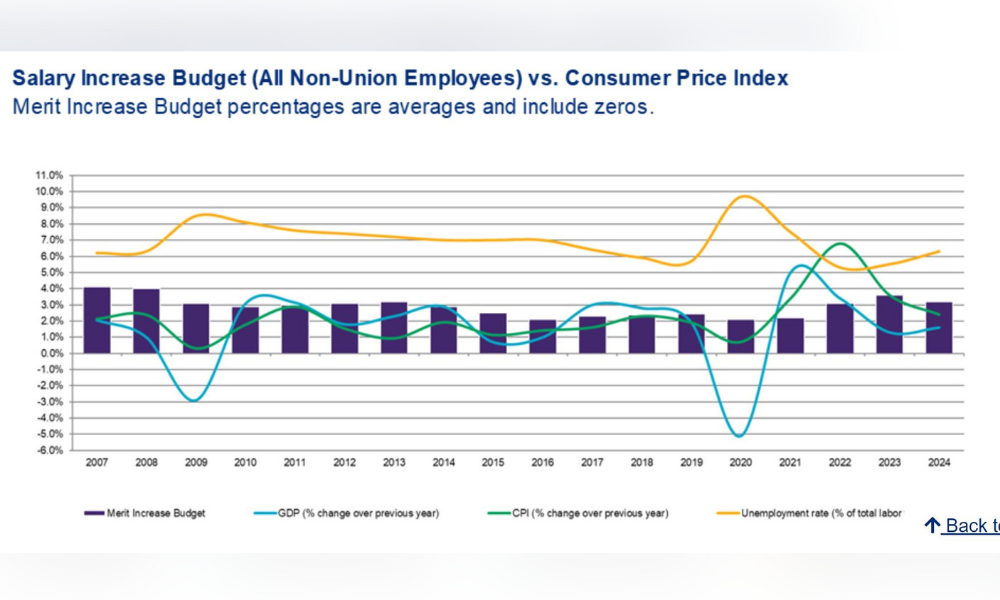2025 compensation spend likely to be less concentrated in base salaries in increases, more on other program elements highly valued by employees

While still higher than before the pandemic, and above inflation, employers compensation budgets are continuing to trend downward, finds the 2024 Mercer QuickPulse™ - Canada Compensation Planning Survey, March results.
In November of 2023 the projected average national merit increase budget was reported as 3.1 percent and the average total increase budget was 3.6 percent. In March, the average merit increase was 3.2 percent, with 3.5 percent total increases reported across the more than 430 participating organizations. While still higher than before the pandemic, and above inflation, increases are continuing to trend downward.
Several industries did provide average merit increases above 3.2 percent. Some of the highest include mining and metals at 3.9 percent and consumer goods and life sciences at 3.5 percent. A few, including high tech and retail and wholesale were well below, only providing 2.6 percent and 2.8 percent average merit increase, respectively.

“Compensation budget increases for 2024 continue to slow,” says Elizabeth English, senior principal, Canadian career practice, Mercer. “While these numbers are still above inflation and higher than pre pandemic increase budgets, we're starting to see it downward trend. It's important that companies use their money wisely to recognize their top performers. Jobs with hot skills use the money to address compression and of course focus on internal equity.”
Fewer promotions planned for 2024
Compared to what they reported in 2023, employers are planning to promote a slightly smaller percentage of employees in 2024 – eight percent on average of all employees versus 8.1 percent the prior year. However, the base pay increase they plan for a one-level promotion is higher than last year, at all levels. Mercers says perhaps this will lead to higher spending on promotions than in years past.
The survey says 48 percent of respondents are giving off-cycle increases on an as-needed basis for a variety of reasons including promotions, retention concerns, internal equity, and market adjustments. Also notable, is the fact that the off-cycle increase spend is highest for the hourly population (0.9 percent on average as compared to 0.8 percent for non-executive salaried employees and 0.6 percent for executives).
Only 15 percent of employers have a dedicated time during the year for off-cycle increases and most commonly they are funded at the BU/department level, through their business/departmental budgets.
English says off cycle increases are provided to employees for a variety of reasons. “Promotions, addressing retention concerns, recognizing increasing job responsibilities, and addressing internal equity are the key reasons why companies are making base salary adjustments outside of their typical annual increase cycle.
“About 85 percent of Canadian companies provide off cycle increases as needed throughout the year, with the rest of employers having fixed time periods when they make their adjustments.
“The labour market is still tight for hourly roles and pay pressure is likely to remain elevated. Off cycle increases are often used to address compression issues which have been caused by minimum wage increases or if new talent joins an organization.
“Companies have been making corrections to the pay of their existing staff. With so many provinces making minimum wage changes, it's important that organizations have a comprehensive hourly pay strategy that isn't just trying to scramble or provide off-cycle adjustments as needed.”
Incentive awards remain unchanged
Short-term incentive payouts for 2023 performance were very similar to those from the prior year. Both years saw a very small percentage paying more than 150 percent of target and about close to half paying from within 10 percent of target up to 150 percent.
Likewise, the long term incentive plan payout versus target was similar this year to last.
The Mercer report shows formal salary structures still reign as the dominant way of managing pay. Now that the dust has settled around working from home, returning to the office, and hybrid work employers report that 41 percent of organizations that operate in multiple locations use a national approach to pay (vs. implementing geographic differentials). Typically, those that use geographic differentials have a national salary structure for all employees (72 percent), with geographic variations of the structure to account for locations with varying costs of labour.
“The broader economic outlook always plays a factor in determining the overall increased budget,” says English. “We're seeing companies be more strategic in how they spend their dollars. A shift towards pay transparency and pay fairness is prompting Canadian employers to go back to basics.
“Organizations are revisiting or reintroducing job architecture. They're putting their salary ranges under a microscope, and they're becoming more robust in their decision making. They are cleaning up their compensation and addressing employees who may be below their range or low in their salary range, relative to their internal peers.”
English says companies should be taking this opportunity to fine tune their total rewards value proposition in order to deliver what employees actually want and need.
“Listening to employees is key and it allows you to understand the unmet needs of your employees by actually asking them what's important to them.
“The spend for 2025 may not be concentrated in base salaries in increases, but rather other program elements that are highly valued by your employees.
“Of course, it's critical to understand what they value first before you introduce new programs.”



